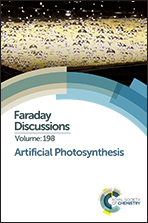Electrochemical CO2 reduction with low overpotential by a poly(4-vinylpyridine) electrode for application to artificial photosynthesis
Abstract
Pyridine molecules have been used as a catalyst to reduce the activation energy of the CO2 reduction reaction. It has been reported that CO2 is reduced by pyridine catalysts at low overpotential around −0.58 V vs. SCE. Poly(4-vinylpyridine), which has pyridine functional groups shows similar catalytic properties to reduce CO2 at low overpotential like pyridinium catalysts. Different thickness of P(4-VP) coated Pt electrodes were analyzed to determine the catalytic properties for CO2 reduction. Cyclic voltammetry, chronoamperometry and electrochemical impedance spectroscopy methods showed the catalytic CO2 reduction properties of a P(4-VP)/Pt electrode. Thin P(4-VP)/Pt film showed a low current density of −0.16 mA cm−2 under CO2 atmosphere and the current density reached −0.45 mA cm−2 with increase of the P(4-VP) thickness. The increase of current density was explained by an increased surface concentration of adsorbed pyridinium groups of the thick P(4-VP) layer. Nyquist plots also showed decrease of impedance with increase of the P(4-VP) layer indicating fast charge transfer between Pt and the P(4-VP) layer due to the increase of hybrid ionic complex formation on the Pt surface. However, charge transfer is restricted when the P(4-VP) layer becomes more thick because of slowed protonation of pyridine groups adjacent to the Pt surface due to the suppressed permeability of electrolyte solution into the PVP membrane. This electrochemical observation provides a new aspect of P(4-VP) polymer for CO2 reduction.
- This article is part of the themed collection: Artificial Photosynthesis

 Please wait while we load your content...
Please wait while we load your content...